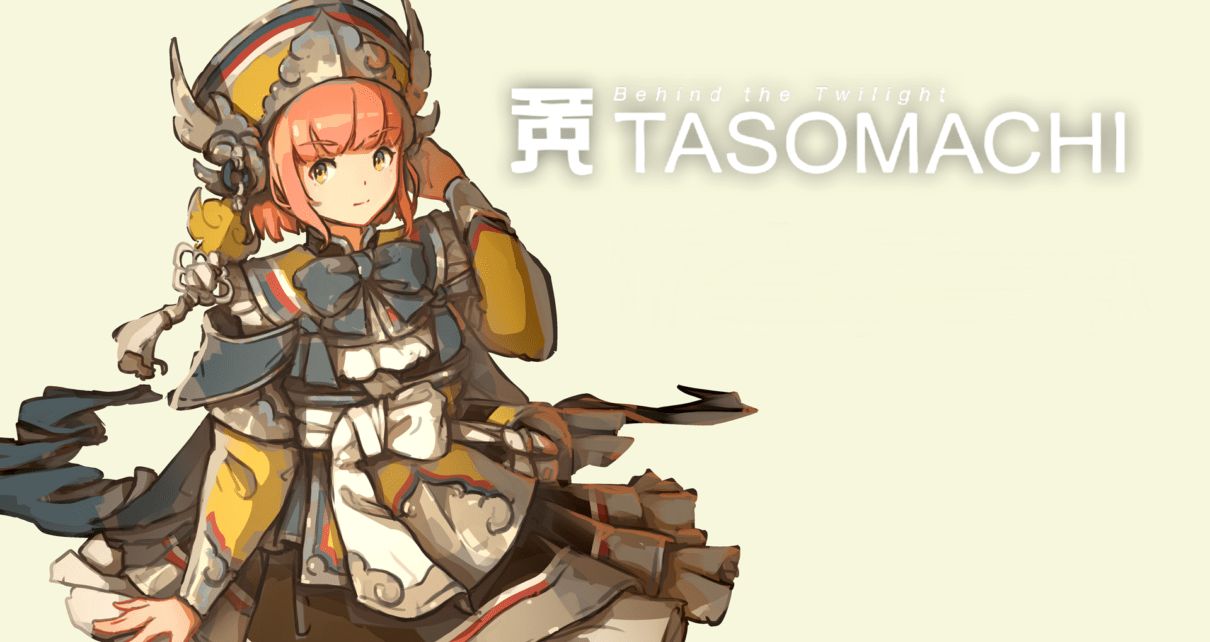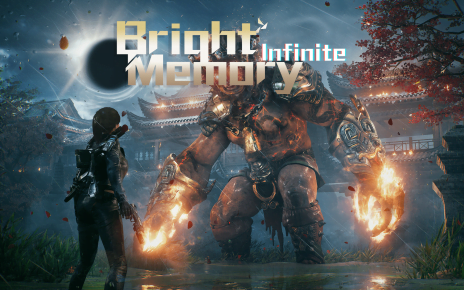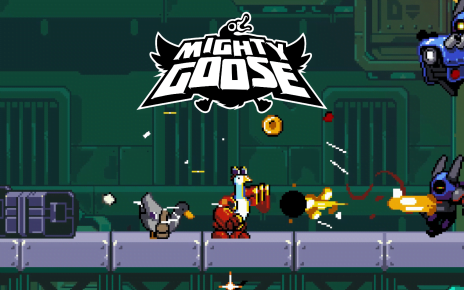Much of the intrigue around TASOMACHI: Behind the Twilight stems from lead developer nocras’s impressive credentials: among them art and environment design for franchises such as Zelda and Final Fantasy. Gorgeous concept art and trailers showcasing expansive environments further piqued my interest. The finished game is a mixed bag, and whether you are likely to enjoy TASOMACHI depends on what you want and expect. A tight and polished platforming collect-a-thon? A narrative with deep mysteries to unearth? In either case, you’re bound to be disappointed. But if you can see TASOMACHI as a game about taking a relaxed approach and enjoying things for what they are, you might find it worthwhile despite its flaws.
A Mysterious Fog
TASOMACHI tells the story of intrepid airship pilot Yukumo and a city called Te-on shrouded in a mysterious twilight fog. After her airship breaks down near Te-on, Yukumo discovers she can repair it if she collects enough sources of earth from the city. These appear as orange lanterns and are TASOMACHI’s main collectible. However, to gain access to the various locales of the city, Yukumo must first disperse the fog. There are also coins scattered about, and there’s no need to feel bad about helping yourself. All the human inhabitants of Te-on have left. Only a race of short cat-like beings called the Nezu remain.
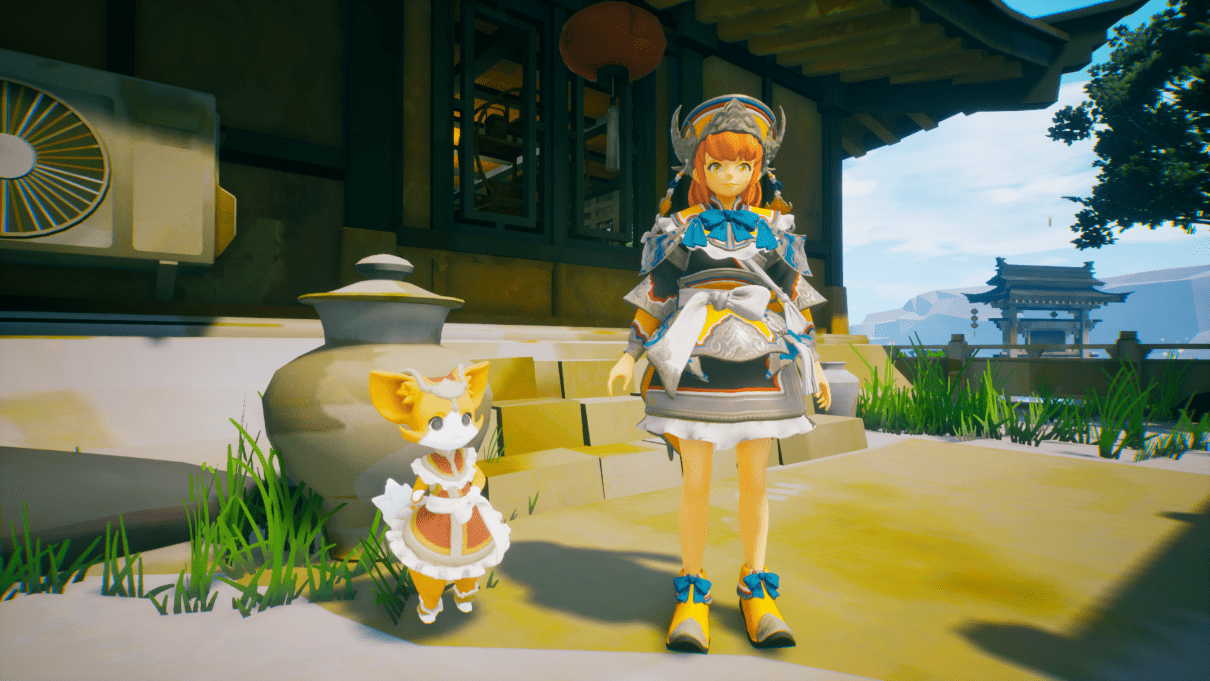
This is about as deep as TASOMACHI’s story ever gets. You can find books here and there with a few sentences of lore, but that’s it. If you’re expecting to unravel an involved mystery explaining the source of this fog or delve into who exactly Yukumo is, TASOMACHI doesn’t pursue those ideas. And this is a constant theme for TASOMACHI. It’s simply not a game that’s meant to push you, either with reflexive challenges or a thought-provoking narrative. Instead, it’s a chill and pleasant experience that wants you to wind down, go at your own pace, and take things for what they are.
Upon reaching a new area of the city, Yukumo’s first task is to banish the fog by reaching a sacred tree sealed away in a shrine. Reaching the tree usually requires completing four platforming segments, each of which rewards you with a source of earth. When you step back into the city after lifting the fog, new areas become available, and the previously abandoned streets spring to life. From there, you explore the revived neighborhoods in search of enough sources of earth to unlock the next district of Te-on. Shrines may also reward Yukumo with a new ability, such as a double jump or short air dash, that can open previously inaccessible areas.
Cityscape Idyll
TASOMACHI is visually striking when viewed on the large scale. This city itself feels as if it sprung up organically and makes excellent use of the vertical. Intricate architecture lines the skies, while plazas with trees and pavilions scattered amongst houses are linked by twisting paths and arching bridges. Each region also makes use of its distinctive topographic features. A seaside port overlooks a bay dotted with islands while a village in a windy gorge sits on terraces built directly into the mountainside. And excepting some distant islands, it’s not just window dressing. You can eventually go most anywhere you can see.

The charm of these environments extends to exploring them, and that’s what you spend most of your time doing. Each district is packed full of sources of earth and coins to collect. Some require specific jumps or doing small tasks for the city’s Nezu inhabitants, such as weeding a plaza. Most though are simply lying around for you to discover. The environments feature interesting verticality created by bridges, scaffoldings, rooftops connected by plankways, and terraced neighborhoods. Teleporters and platforms that launch Yukumo into the air give traversal a pleasing flow. As the city grows livelier, Yukumo can even hitch rides on boats and airships to get around town. Most of the sources of earth aren’t hard to find once you have the right abilities, but I liked this. It’s easy to just indulge in the pleasure of a leisurely jaunt through the city, and you’re almost always rewarded for taking the time to peek around a corner or under a ledge. Collecting the sources of earth you need is relaxing rather than tense or tedious.
On the granular level, TASOMACHI’s seams start to become visible. Many of the assets, while pretty, are frequently re-used across the city districts with only a new paint job. Yukumo herself is like a doll. She’s attractive when viewed from afar, but inhuman up close. Her animations feel slightly off, and her facial expression never changes from a vacant smile. Having her close her eyes when praying or adding a simple blinking animation would have gone a long way toward making her feel more lifelike. And this sentiment sums up my feelings about the visuals in general. Everything is appealing in some way, but most of it lacks the nuanced and lovingly crafted details that separate a pretty game from a beautiful game.

Problems with Platforming
TASOMACHI’s movement also falters under scrutiny. Running and jumping feel a bit awkward, and the controls are quite floaty. This isn’t a huge deal when exploring the city, but things start to fall apart in the shrines’ platforming segments. Yukumo can only jump to her maximum jump height, and it’s difficult to control her momentum in midair. As a result, precision jumps require constant small adjustments and changes of direction, and the game never develops the fluidity of motion found in good platformers. Some rooms are “puzzles” rather than jumps, but these can only be solved by trial and error. One particularly odious room combines the worst of both by requiring you to memorize the locations of invisible blocks and then jump on them. Even with its issues, the platforming is rarely difficult. But what little difficulty exists comes almost entirely from poor controls and physics.
The platforming sections are the worst parts of TASOMACHI, but you actually don’t have to play them. You can instead spend 20 coins to activate a teleporter that will zap you across the room to your goal. This might seem bizarre. Why would a game let you spend in-world money to not play the game? However, I think it works here and fits with the theme of encouraging a laid-back experience. If the platforming isn’t fun but you enjoy other parts of the game, well you don’t have to do the part you dislike. I played all the platforming sections for the purpose of my review, but if I were to replay TASOMACHI I would pay coins to skip many of them.
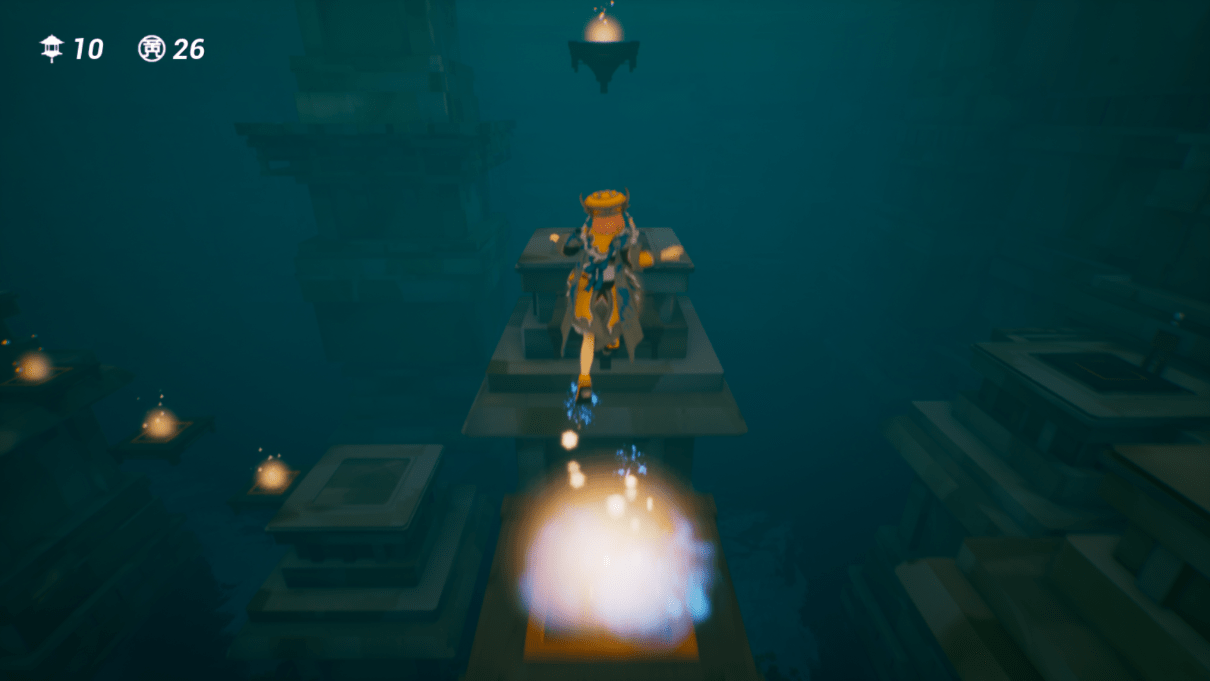
Sailing the Skies
The airship, on the other hand, is a pleasure to pilot. Its movement is fluid and easy to master, and fitting through tight spaces, such as under bridges, is for the most part a smooth experience. After unlocking the airship, you can find gates that let you navigate circuits through the various districts of Te-on to earn sources of earth. I enjoyed these, and like everything else, there’s no pressure. You’re not timed, and there’s no way to fail.
Each district of the city has a shop, and you can spend the coins you’ve collected at these to unlock new outfits for Yukumo as well as cosmetics for your home base. The outfits have a cosplay feel with themes like maid or foxgirl. Coins respawn upon re-entering an area, so you can buy without needing to worry about exhausting the supply of money. You can also unlock one more shop after completing the main story that offers a reward for collecting all 244 sources of earth. After collecting 201, which took about 6 hours, I was ready to put TASOMACHI down, so I don’t know what you get. I suspect it’s a costume.
Chill Beats
The music honestly surprised me was easily my favorite part of TASOMACHI. I expected some forgettable anime BGM piano noodling. Instead, a thoughtful soundtrack draws from lo-fi, minimalism, and impressionism. Each piece is perfectly crafted to complement Yukumo’s journey. The shrine tracks are more rhythmic but still fall into a chill groove. They less drive you forward and more pat you on the back and tell you it’s time for a little focus. The city districts are accompanied by a solemn lament when shrouded in fog. But once you restore life to the city, this is replaced with warm and soothing pieces that evoke a seaside afternoon painted in sunlight or a cool, breezy evening in the mountains. Even when Yukumo takes to the skies in her airship and the soundtrack reaches its most intense and exuberant moments, it never loses its sense of restraint. It’s an ideal accompaniment to TASOMACHI’s laid-back gameplay and idyllic environments.

Verdict
I enjoyed TASOMACHI: Behind the Twilight, especially the soundtrack. I found it a pleasant way to unwind after a long day. Despite its charm, I don’t think it warrants an unreserved recommendation. The platforming is clumsy and uninspired, and the story is bare-bones. The visuals are attractive but lack the above and beyond quality they’d need to carry the game on their own. If a simple and laid-back experience sounds appealing, I think TASOMACHI is worth a look. If you want substantial platforming or narrative, you should play something else.
WAIT FOR SALE ON TASOMACHI: BEHIND THE TWILIGHT
If you would like to see more relaxing Adventure games, you may be interested in our review of Giraffe and Annika.
Many thanks to PLAYISM for a PC review code for this title.
A veteran of Oregon Trail and Battletoads, Wes has been playing and talking about games for as long as he can remember. He’s down to try almost anything, and he especially enjoys games with gripping narrative experiences.

